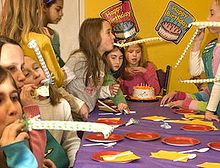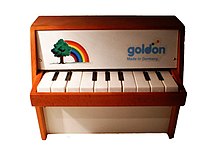Toy instrument
Toy instruments are easiest musical instruments or instrument similar replicas that for the game of children are conceived.
They are therefore something different from children's instruments , which correspond to real instruments and have only smaller dimensions so that children can play them more easily (e.g. smaller string instruments , pianos with narrower keys), or are more simply equipped to avoid high purchase costs for a first instrument to avoid.
history
The beginnings of toy instruments probably go back as far in the past as toys in general.
In the 18th century, the Berchtesgadener Land was known for its sounding toys, as a form of the Berchtesgadener War . In this geographical context, the “ Children's Symphony ” ( attributed to Edmund Angerer , around 1770) was created, with which toy instruments were first considered in art music.
In 1948 John Cage wrote another well-known composition for a toy instrument with his "Suite for Toy Piano ". Bernd Wiesemann is a well-known German composer who often uses the toy piano.
Examples of toy instruments
Most toy instruments can be roughly divided into two categories: instrument-like replicas of real instruments on the one hand and “stand-alone” toy instruments on the other. With the latter, the transition to conventional musical instruments is fluid. Many noise instruments in particular are very easy to play even by children and are often used as toy instruments.
- Replicas of real instruments:
- Many noise instruments are suitable as toy instruments due to their small size, the easy-to-learn playing style and the often low price. In contrast to the replicas of real instruments, they are not limited to use as toys, but are also used for other purposes, e.g. B. at sporting events and in early musical education . Therefore, they are usually seen as more educationally valuable. Typical examples are:
- Whistle - probably the most common noise instrument among children
- Recorder head
- ratchet
- Horn , Vuvuzela
The common feature of the instruments in this category is their very high volume . It makes sense to use earplugs when playing for a long time .
In addition, countless sound toys of inferior quality are offered in the trade and are called "musical instruments", but the name i. d. R. do not earn.

Furthermore, rhythm instruments, especially rattles , are used as toy instruments. Here are Maracas quite popular, sometimes (especially the very loud versions) supplemented by a whistle. Eggshakers are a quieter variant .
criticism
As long as it stays with ordinary baby rattles and the like, toy instruments are generally accepted as a sound-oriented variant of toys. Stylized and only supposedly child-friendly imitations of real musical instruments are seen by critics as a mockery of the child's natural musicality, because their limited possibilities lead to disappointment when a child tries to make music on them seriously.
Today, in extreme cases, toy instruments only roughly approximate their models and often generate sounds electronically without the need for an actual instrumental operation.
As a rule, only the 'correct' noise / rhythm / effect instruments listed above are recommended, which also have the advantage that they can still be used well later when the children are out of childhood. Maracas, eggshakers, whistles or recorder heads are also widely used in modern music and are also recommended for children without restriction.
literature
M. & W. Jehn: Musical toy box
Web links
- Central Europe, Burgenland - production of simple children's toys (Maipfeiferl, Rindenoboe, Hollerbüchse, Zitterwagen). Image from the collection of the Federal Institute for Scientific Film (ÖWF) in the Austrian Media Library , 1987

